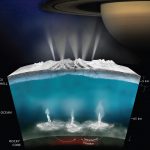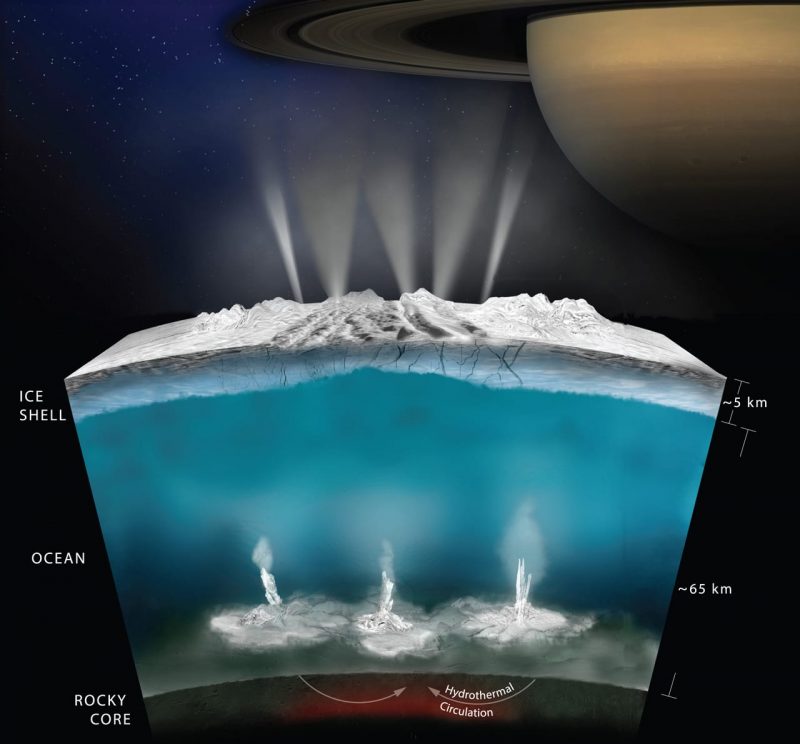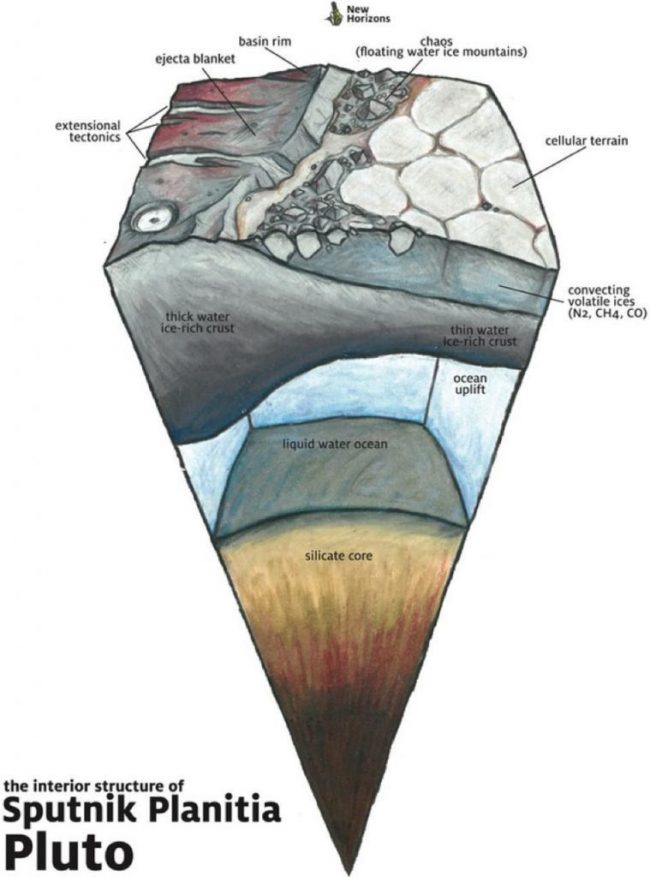

Artist’s illustration of an ocean world, where the ocean is hidden beneath a crust of ice and rock. New research suggests such worlds are common in our galaxy and some of them may even be better suited for life than Earth’s oceans. Image via NASA/ JPL-Caltech/ Southwest Research Institute.
Worlds with oceans beneath layers of rock and ice are common in our solar system. According to research presented at last week’s Lunar and Planetary Science Conference (March 15-19, 2021), worlds with underground oceans are likely to be common in other solar systems in our galaxy, the Milky Way, as well, and these subsurface oceans might be even better environments for life than Earth’s oceans.
When you hear “ocean world,” you might think of Earth. About 71% of the Earth’s surface is water-covered. And although our blue planet is the only world in our solar system with abundant liquid water on its surface, numerous moons and even some dwarf planets have oceans below their icy and rocky surfaces. For example, Europa, a moon of Jupiter, and Enceladus, a moon of Saturn, are thought to have interior water oceans. Even Titan, Saturn’s large moon – a world with both small and large bodies of both liquid methane and ethane on its surface – is also thought to have an interior water ocean. And even distant dwarf-planet Pluto might have a subsurface ocean. Some scientists call these places interior water ocean worlds.
Now, a newly-announced study from planetary scientist Alan Stern at the Southwest Research Institute (SwRI) suggests that these kinds of watery worlds are likely to be common in other solar systems as well as our own, and that their interior oceans might be even better environments for life than Earth’s oceans.
Stern’s new paper was presented at the 52nd annual Lunar and Planetary Science Conference (LPSC 52) last week.
That possibility is exciting enough in itself, but Stern goes on to say that these kinds of oceans may be even better places for life than Earth’s oceans. He stated:
Interior water ocean worlds are better suited to provide many kinds of environmental stability, and are less likely to suffer threats to life from their own atmosphere, their star, their solar system, and the galaxy, than are worlds like Earth, which have their oceans on the outside.

Europa is one of the best known ocean worlds in our solar system. A global ocean of water, possibly able to support life, lies beneath its outer icy shell. Image via NASA/ JPL-Caltech.

On Saturn’s moon Enceladus, huge geysers of water vapor erupt from the subsurface ocean below. Enceladus’ ocean is also thought to be habitable, with active hydrothermal vents on the ocean floor. Image via NASA/ JPL-Caltech/ Space Science Institute.
The ability of a planet to have oceans on its surface is dependent on various factors, including a narrow range of distances from its star – the habitable zone – where temperatures could allow liquid water to exist. As we have found in our own solar system, however, interior water ocean worlds can exist at a much broader range of distances. How? In the case of some ocean moons, for example, the gravitational tugging from their parent planets, like Jupiter and Saturn, and probably Uranus and Neptune as well, can create enough heat, along with perhaps radioactive decay, which also produces heat, to allow water to remain liquid in their interiors. Their surfaces are still frozen, since they are exposed to space with little to no atmospheres, but below the ice crust, oceans can exist.
Those oceans can even be global, as we have seen with Europa and Enceladus, and maybe others as well. Amazingly, even though Europa is a small moon, it has more liquid in its ocean than all of the oceans on Earth combined!
Until recently, few people would have thought of Pluto, of all places, to be able to have liquid water, but the continuing study of data sent back by the New Horizons spacecraft suggests just that.
So if oceans can exist in so many places just within our own solar system, there is a great possibility of there being many such worlds out there around other stars as well.
Not only does the prospect of many ocean worlds increase the chances of alien life elsewhere, it also means that any such life would be better protected and in a more stable environment than it would be in oceans on the surfaces of planets. Oceans under an icy and rocky crust would be protected from the environmental effects of meteorite and comet impacts, radiation from the star and even supernovas.

There is now even evidence for a subsurface ocean on Pluto, of all places! This is a diagram of what the interior of Pluto might look like below Sputnik Planitia (the cellular terrain on the right side, on top). The ice crust above the water is thinner in this region. Image via James Tuttle Keane/ Medium.com/ Starts With a Bang!.
Stern said:
Interior water ocean worlds are better suited to provide many kinds of environmental stability, and are less likely to suffer threats to life from their own atmosphere, their star, their solar system, and the galaxy, than are worlds like Earth, which have their oceans on the outside.
There is one downside to all this however. Even if life exists in many of these hidden oceans, the fact that they are concealed beneath ice and rock would make it very difficult to ever detect it from Earth. As Stern noted:
The same protective layer of ice and rock that creates stable environments for life also sequesters that life from easy detection.
It is possible though, that some evidence of that life could be found on the surfaces of these worlds, since as we have seen with Enceladus, and likely Europa as well, some of the ocean water can make its way to the surface in geysers. It still wouldn’t be easy, but it’s conceivable that material from the ocean that is deposited onto the surface, could be detectable and analyzed by telescopes.
In our solar system, Europa and Enceladus in particular are now considered to be two of the most promising places to look for extraterrestrial life, even if it is only microbes or alien shrimp. There is now evidence for hydrothermal vents on the ocean floor of Enceladus, much like the ones on the ocean floor on Earth. Even if the rest of the ocean were cold and dark, hydrothermal vents could provide heat and nutrients for living organisms. Such vents may also exist on the ocean floor of Europa. Other analysis from the Cassini mission has also shown that these oceans are quite similar to Earth’s oceans in other ways, for example, in terms of salinity and chemical composition.

The new study was led by Alan Stern, a planetary scientist at Southwest Research Institute. Stern is well-known for leading the New Horizons mission to Pluto. Image via United States Embassy in Uruguay/ Wikimedia Commons.
If this latest research is correct, there may be millions (even billions?) of other Europas and Enceladuses out there. If so, our galaxy could be literally swimming with life.
If more primitive forms of life are common on ocean worlds, what about intelligent life? There may well be, like alien octopuses as an example, but technologically advanced life would probably be more limited, as discussed in the paper:
Interior water ocean worlds are habitable in a wider range of host worlds and stellar and galactic environments than do worlds with exterior water oceans. As a result, interior water ocean worlds may contain life more frequently than exterior water ocean worlds, like Earth. However, for the reasons discussed above, such intelligent life would be less likely to develop an awareness of the universe and space travel, and therefore may be less likely to communicate actively or passively (i.e., via electromagnetic leakage) than intelligent life on external ocean worlds like Earth.
Bottom line: New research suggests that subsurface ocean worlds, like some moons and dwarf planets in our own solar system, are common and may be even better environments for life than Earth’s oceans.
Source: Some Implications for Both Life and Civilizations Regarding Interior Water Ocean Worlds
from EarthSky https://ift.tt/3cXgm8e


Artist’s illustration of an ocean world, where the ocean is hidden beneath a crust of ice and rock. New research suggests such worlds are common in our galaxy and some of them may even be better suited for life than Earth’s oceans. Image via NASA/ JPL-Caltech/ Southwest Research Institute.
Worlds with oceans beneath layers of rock and ice are common in our solar system. According to research presented at last week’s Lunar and Planetary Science Conference (March 15-19, 2021), worlds with underground oceans are likely to be common in other solar systems in our galaxy, the Milky Way, as well, and these subsurface oceans might be even better environments for life than Earth’s oceans.
When you hear “ocean world,” you might think of Earth. About 71% of the Earth’s surface is water-covered. And although our blue planet is the only world in our solar system with abundant liquid water on its surface, numerous moons and even some dwarf planets have oceans below their icy and rocky surfaces. For example, Europa, a moon of Jupiter, and Enceladus, a moon of Saturn, are thought to have interior water oceans. Even Titan, Saturn’s large moon – a world with both small and large bodies of both liquid methane and ethane on its surface – is also thought to have an interior water ocean. And even distant dwarf-planet Pluto might have a subsurface ocean. Some scientists call these places interior water ocean worlds.
Now, a newly-announced study from planetary scientist Alan Stern at the Southwest Research Institute (SwRI) suggests that these kinds of watery worlds are likely to be common in other solar systems as well as our own, and that their interior oceans might be even better environments for life than Earth’s oceans.
Stern’s new paper was presented at the 52nd annual Lunar and Planetary Science Conference (LPSC 52) last week.
That possibility is exciting enough in itself, but Stern goes on to say that these kinds of oceans may be even better places for life than Earth’s oceans. He stated:
Interior water ocean worlds are better suited to provide many kinds of environmental stability, and are less likely to suffer threats to life from their own atmosphere, their star, their solar system, and the galaxy, than are worlds like Earth, which have their oceans on the outside.

Europa is one of the best known ocean worlds in our solar system. A global ocean of water, possibly able to support life, lies beneath its outer icy shell. Image via NASA/ JPL-Caltech.

On Saturn’s moon Enceladus, huge geysers of water vapor erupt from the subsurface ocean below. Enceladus’ ocean is also thought to be habitable, with active hydrothermal vents on the ocean floor. Image via NASA/ JPL-Caltech/ Space Science Institute.
The ability of a planet to have oceans on its surface is dependent on various factors, including a narrow range of distances from its star – the habitable zone – where temperatures could allow liquid water to exist. As we have found in our own solar system, however, interior water ocean worlds can exist at a much broader range of distances. How? In the case of some ocean moons, for example, the gravitational tugging from their parent planets, like Jupiter and Saturn, and probably Uranus and Neptune as well, can create enough heat, along with perhaps radioactive decay, which also produces heat, to allow water to remain liquid in their interiors. Their surfaces are still frozen, since they are exposed to space with little to no atmospheres, but below the ice crust, oceans can exist.
Those oceans can even be global, as we have seen with Europa and Enceladus, and maybe others as well. Amazingly, even though Europa is a small moon, it has more liquid in its ocean than all of the oceans on Earth combined!
Until recently, few people would have thought of Pluto, of all places, to be able to have liquid water, but the continuing study of data sent back by the New Horizons spacecraft suggests just that.
So if oceans can exist in so many places just within our own solar system, there is a great possibility of there being many such worlds out there around other stars as well.
Not only does the prospect of many ocean worlds increase the chances of alien life elsewhere, it also means that any such life would be better protected and in a more stable environment than it would be in oceans on the surfaces of planets. Oceans under an icy and rocky crust would be protected from the environmental effects of meteorite and comet impacts, radiation from the star and even supernovas.

There is now even evidence for a subsurface ocean on Pluto, of all places! This is a diagram of what the interior of Pluto might look like below Sputnik Planitia (the cellular terrain on the right side, on top). The ice crust above the water is thinner in this region. Image via James Tuttle Keane/ Medium.com/ Starts With a Bang!.
Stern said:
Interior water ocean worlds are better suited to provide many kinds of environmental stability, and are less likely to suffer threats to life from their own atmosphere, their star, their solar system, and the galaxy, than are worlds like Earth, which have their oceans on the outside.
There is one downside to all this however. Even if life exists in many of these hidden oceans, the fact that they are concealed beneath ice and rock would make it very difficult to ever detect it from Earth. As Stern noted:
The same protective layer of ice and rock that creates stable environments for life also sequesters that life from easy detection.
It is possible though, that some evidence of that life could be found on the surfaces of these worlds, since as we have seen with Enceladus, and likely Europa as well, some of the ocean water can make its way to the surface in geysers. It still wouldn’t be easy, but it’s conceivable that material from the ocean that is deposited onto the surface, could be detectable and analyzed by telescopes.
In our solar system, Europa and Enceladus in particular are now considered to be two of the most promising places to look for extraterrestrial life, even if it is only microbes or alien shrimp. There is now evidence for hydrothermal vents on the ocean floor of Enceladus, much like the ones on the ocean floor on Earth. Even if the rest of the ocean were cold and dark, hydrothermal vents could provide heat and nutrients for living organisms. Such vents may also exist on the ocean floor of Europa. Other analysis from the Cassini mission has also shown that these oceans are quite similar to Earth’s oceans in other ways, for example, in terms of salinity and chemical composition.

The new study was led by Alan Stern, a planetary scientist at Southwest Research Institute. Stern is well-known for leading the New Horizons mission to Pluto. Image via United States Embassy in Uruguay/ Wikimedia Commons.
If this latest research is correct, there may be millions (even billions?) of other Europas and Enceladuses out there. If so, our galaxy could be literally swimming with life.
If more primitive forms of life are common on ocean worlds, what about intelligent life? There may well be, like alien octopuses as an example, but technologically advanced life would probably be more limited, as discussed in the paper:
Interior water ocean worlds are habitable in a wider range of host worlds and stellar and galactic environments than do worlds with exterior water oceans. As a result, interior water ocean worlds may contain life more frequently than exterior water ocean worlds, like Earth. However, for the reasons discussed above, such intelligent life would be less likely to develop an awareness of the universe and space travel, and therefore may be less likely to communicate actively or passively (i.e., via electromagnetic leakage) than intelligent life on external ocean worlds like Earth.
Bottom line: New research suggests that subsurface ocean worlds, like some moons and dwarf planets in our own solar system, are common and may be even better environments for life than Earth’s oceans.
Source: Some Implications for Both Life and Civilizations Regarding Interior Water Ocean Worlds
from EarthSky https://ift.tt/3cXgm8e

Aucun commentaire:
Enregistrer un commentaire